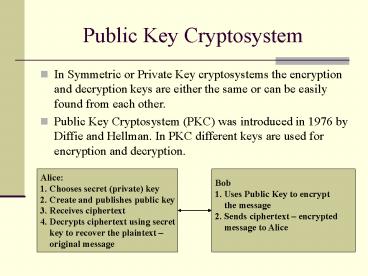Public Key Cryptosystem PowerPoint PPT Presentation
Title: Public Key Cryptosystem
1
Public Key Cryptosystem
- In Symmetric or Private Key cryptosystems the
encryption and decryption keys are either the
same or can be easily found from each other. - Public Key Cryptosystem (PKC) was introduced in
1976 by Diffie and Hellman. In PKC different keys
are used for encryption and decryption.
Alice 1. Chooses secret (private) key 2. Create
and publishes public key 3. Receives
ciphertext 4. Decrypts ciphertext using secret
key to recover the plaintext original
message
Bob 1. Uses Public Key to encrypt the
message 2. Sends ciphertext encrypted
message to Alice
2
Public Key Cryptosystem
1978 First Two Implementation
RSA Rivest-Shamir-Adleman Based on integer
factorization
Merkle-Hellman Knapsack Cryptosystem Based on
the subset-sum problem, variant of knapsack
problem
Additive Knapsack Cryptosystem
Multiplicative Knapsack Cryptosystem
Multiply-Iterated Knapsack Cryptosystem
3
Merkle-Hellman Knapsack Cryptosystem Example
- Alice Private Key
- Private Key A 1, 2, 4, 8, M 17, W 7, w
5 - Public Key B 7, 14, 11, 5
- Bob Encryption
- Plaintext 1101
- Ciphertext 7 14 5 26
- Alice Decryption
- 526 (mod 17) 11
- 11 11 12 04 18
- Plaintext 1101
4
Bob
Alice
Creates Cryptosystem
Decrypts Ciphertext
Plaintext P1101
Private Key A 1, 2, 4, 8 M 17, W 7 w 5
Public Key B 7, 14, 11, 5
Encryption Using Public Key 17 1 14 0111
5 26
Decryption 526 (mod 17) 11 11 11 12
04 18
Ciphertext 26
Plaintext 1101
5
Merkle-Hellman Knapsack Cryptosystem
- 1982 Singly-iterated Merkle - Hellman Knapsack
Cryptosystem was broken by Adi Shamir - 1983 At the CRYPTO 83 , Adleman used an Apple
II computer to demonstrate Shamirs method - 1985 Multiply-iterated Merkle-Hellman knapsack
was broken by Brickell, a system of 40 iterations
was breaking in about an hour of Cray-1 time
6
Classical Knapsack Problem
- General 0-1 knapsack problem given n items of
different values vi and weights wi, find the most
valuable subset of the items while the overall
weight does not exceed a given capacity W - The knapsack problem is NP-hard
- The knapsack problem could be solved in
pseudo-polynomial time through dynamic
programming
7
Subset-Sum Problem
- Subset Sum problem is a special case of
knapsack problem when a value of each item is
equal to its weight - Input set of positive integers A a1, a2,
an and the positive integer S - Output
- TRUE, if there is a subset of A that sums to S
and the subset itself - FALSE otherwise.
- The subset-sum problem is NP-hard
8
Easy Knapsack Problem
- An easy knapsack problem is one in which set
- A a1, a2, an is a super-increasing
sequence - A super-increasing sequence is one in which the
next term of the sequence is greater than the sum
of all preceding terms - a2 gt a1, a3 gt a1 a2,., an gt a1 a2
an-1 - Example A 1, 2, 4, 8, 2n-1 is
super-increasing sequence
9
Polynomial Time Algorithm for Easy Knapsack
Problem
- Input A a1, an is super-increasing
sequence, S - Output TRUE and P binary array of n elements,
Pi 1 means ai belongs to subset of A that
sums to S, P0 0 otherwise. The algorithm
returns FALSE if the subset doesnt exist - for i ? n to 1
- if S ? ai
- then Pi ? 1 and S ? S - ai else
Pi ? 0 - if S ! 0
- then return (FALSE no solution) else return
(P1, P2, Pn).
10
Merkle-Hellman Additive Knapsack Cryptosystem
Alice 1. Constructs the Knapsack
cryptosystem 2. Publishes the public key 3.
Receives the ciphertext 4. Decrypts the
ciphertext using private key
- Bob
- Encrypts the plaintext using public key
- Sends the plaintext to Alice
11
Alice Knapsack Cryptosystem Construction
- Chooses A a1, an super-increasing sequence,
- A is a private (easy) knapsack
- a1 an E
- Chooses M - the next prime larger than E.
- Chooses W that satisfies 2 ? W lt M and (W, M) 1
- Computes Public (hard) knapsack B b1, .bn,
where bi Wai (mod M), 1 ? i ? n - Keeps Private Key A, W, M
- Publishes Public key B
12
Bob Encryption Process
- Binary Plaintext P breaks up into sets of n
elements long P P1, Pk - For each set Pi compute
- Ci is the ciphertext that corresponds to
plaintext Pi - C C1, Ck) is ciphertext that corresponds to
the plaintext P - C is sent to Alice
13
Alice Decryption Process
- Computes w, the multiplicative inverse of W mod
M - wW ? 1 (mod M)
- The connection between easy and hard knapsacks
- wai bi (mod M), 1 ? i ? n
- For each Ci computes Si wCi (mod M)
- Plaintext Pi could be found using polynomial time
algorithm for easy knapsack
14
Example
- Alice Private Key
- A 1, 2, 4, 8, M 17, W 7, 2 ? W lt 17,
(7, 17) 1 - Public Key
- B7 mod 17, 14 mod 17, 28 mod 17, 56 mod
177, 14, 11, 5 - Bob Encryption
- Plaintext 1101
- Ciphertext 7 14 5 26
- Alice Decryption
- w 5 multiplicative inverse of 7 (mod 17)
- 526 (mod 17) 11
- Plaintext 1101 (11 11 12 04 18)

